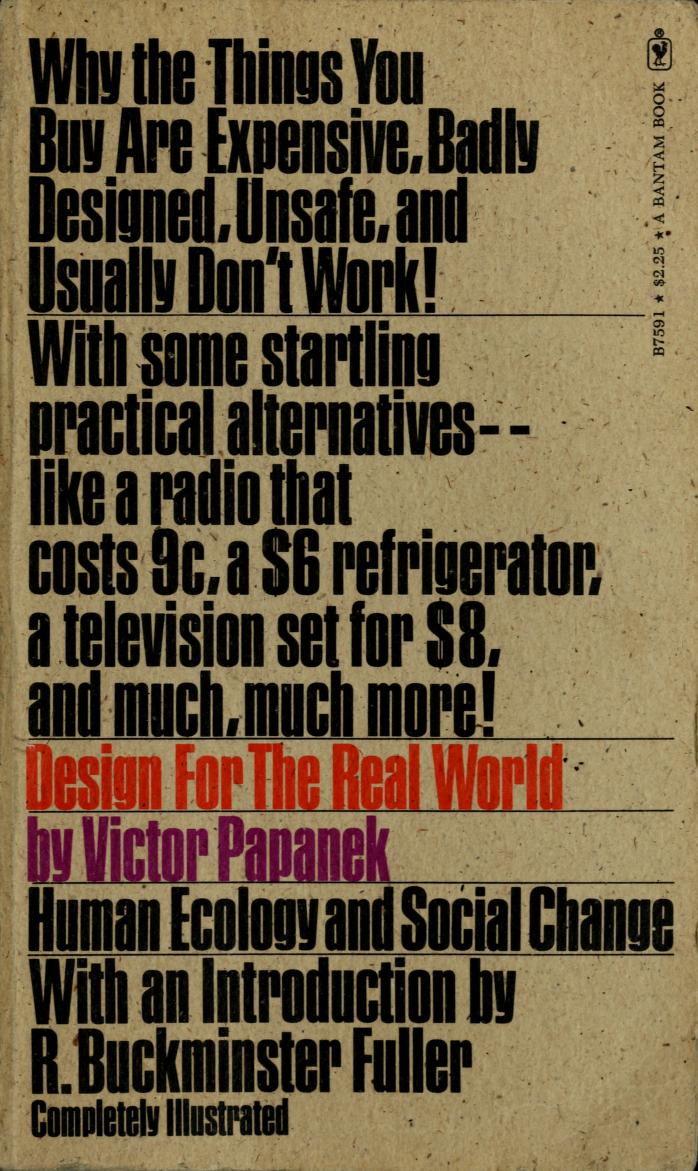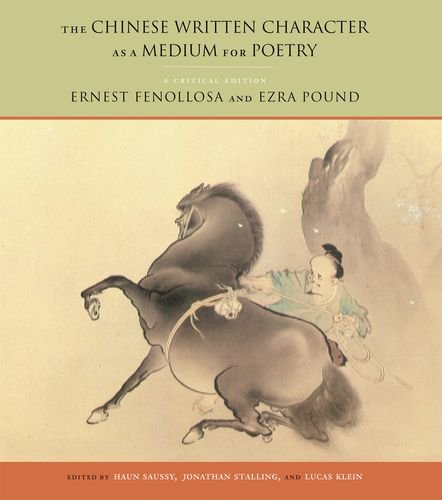Victor Papanek: Design for the Real World: Human Ecology and Social Change (1972–) [EN, CR, ES, RO, RU, DE]
Filed under book | Tags: · architecture, consumerism, design, diy, environment, ethics, industrial design, recycling

“Design for the Real World has become a classic. Translated into twenty-three languages, it is one of the world’s most widely read books on design and is a required text in many design and architectural schools. Victor Papanek examines the attempts by designers to combat the tawdry, the unsafe, the frivolous, the useless product, once again providing a blueprint for sensible, responsible design in this world which is deficient in resources and energy.”
With an Introduction by R. Buckminster Fuller
Publisher Pantheon Books, 1972
Bantam Books edition, 1973
371 pages
Reviews: Jackson (Journal of Design History, 1993), Johnson (Designophy, n.d.), Jepson (n.d.).
Commentaries: Rawsthorn (The New York Times, 2011), Hawthorne (Metropolis Magazine, 2012).
Design for the Real World (English, 1972/73, 56 MB, no OCR), 2nd edition, revised (1984, 89 MB, via Scribd)
Dizajn za stvarni svijet (Croatian, trans. Branka Đukić, 1973, 10 MB, via Mama)
Diseñar para el mundo real (Spanish, trans. Luis Cortes de Alvaro, 1977, 134 MB, no OCR, via Scribd)
Design pentru lumea reală (Romanian, trans. Florentina Badea and Cornelia Stănescu, 1997, 51 MB, via Scribd)
Дизайн для реального мира (Russian, trans. Galin Severskoy, 2004)
Design für die reale Welt (German, trans. Elisabeth Frank-Großebner, 2009, 8 MB)
See also Bisociation Tool – Victor Papanek’s “Paper Computer”, 2004.
Comment (0)Ernest Fenollosa, Ezra Pound: Chinese Written Character as a Medium for Poetry (1919–)
Filed under book, essay | Tags: · literature, poetics, poetry

“First published in 1919 by Ezra Pound, Ernest Fenollosa’s essay on the Chinese written language has become one of the most often quoted statements in the history of American poetics. As edited by Pound, it presents a powerful conception of language that continues to shape our poetic and stylistic preferences: the idea that poems consist primarily of images; the idea that the sentence form with active verb mirrors relations of natural force. But previous editions of the essay represent Pound’s understanding—it is fair to say, his appropriation—of the text. Fenollosa’s manuscripts, in the Beinecke Library of Yale University, allow us to see this essay in a different light, as a document of early, sustained cultural interchange between North America and East Asia.
Pound’s editing of the essay obscured two important features, here restored to view: Fenollosa’s encounter with Tendai Buddhism and Buddhist ontology, and his concern with the dimension of sound in Chinese poetry.
This book is the definitive critical edition of Fenollosa’s important work. After a substantial Introduction, the text as edited by Pound is presented, together with his notes and plates. At the heart of the edition is the first full publication of the essay as Fenollosa wrote it, accompanied by the many diagrams, characters, and notes Fenollosa (and Pound) scrawled on the verso pages. Pound’s deletions, insertions, and alterations to Fenollosa’s sometimes ornate prose are meticulously captured, enabling readers to follow the quasi-dialogue between Fenollosa and his posthumous editor. Earlier drafts and related talks reveal the developmentof Fenollosa’s ideas about culture, poetry, and translation. Copious multilingual annotation is an important feature of the edition.”
Critical edition
Edited by Haun Saussy, Jonathan Stalling, and Lucas Klein
Publisher Fordham University Press, 2008.
ISBN 0823228681, 9780823228683
240 pages
Reviews: Armstrong (Sign Language Studies, 2009), Nicholls (Modernism/modernity, 2010), Beam (Oyster Boy Review, 2012).
Commentary: Williams (2009).
Publisher (2008)
Fenollosa’s documents in the Beinecke Library.
Version published in The Little Review, 1919: 6:5 (Sep 1919), 62-64, 6:6 (Oct 1919), 57-64, 6:7 (Nov 1919), 55-60, 6:8 (Dec 1919), 68-72 (at Index of Modernist Magazines).
Version printed in Instigations, 1920, 357-388 (at Internet Archive), HTML (at Project Gutenberg).
Critical edition, 2008: EPUB.
Roberto González Echevarría: Myth and Archive: A Theory of Latin American Narrative (1990–) [EN, ES]
Filed under book | Tags: · anthropology, archive, christianity, city, history, history of literature, latin america, law, literary theory, literature, myth, narrative, rhetoric, violence, writing

“This book offers a theory about the origin and evolution of the Latin American narrative, and about the emergence of the modern novel. It argues that the novel developed from the discourse of the law in the Spanish Empire during the sixteenth century, while many of the early historical documents concerning the New World assumed the same forms, furnished by the notarial arts. Thus, both the novel and these first Latin American narratives imitated the language of authority. The book explores how the same process is repeated in two key moments in the history of the Latin American narrative. In the nineteenth century, the model was the discourse of scientific travellers such as von Humboldt and Darwin, while in the twentieth century, the discourse of anthropology – the study of language and myth – has come to shape the narrative. Professor González Echevarría’s theoretical approach is drawn from a reading of Carpentier’s Los pasos perdidos, and the book centres on major figures in the tradition such as Columbus, Garcilaso el Inca, Sarmiento, Gallegos, Borges and Garcia Marquez.”
Publisher Cambridge University Press, 1990
ISBN 0521023998, 9780521023993
245 pages
Review (Terry J. Peavler, Latin American Research Review, c1990, EN)
Review (Margarita Zamora, Hispanic Review, 1992, EN)
Review (Adriana Gordillo, Fronteras de la historia, 2003, ES)
Publisher (EN)
WorldCat (EN)
WorldCat (ES)
Myth and Archive (PDF), PDF (English, 1990)
Mito y archivo: una teoría de la narrativa latinoamericana (Spanish, trans. Virginia Aguirre Muñoz, PDF, 77 MB, via Academia.edu)

